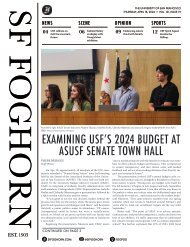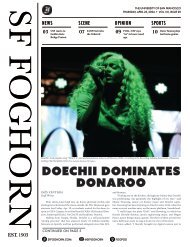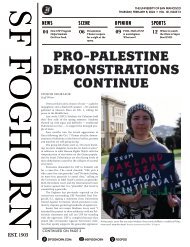Create successful ePaper yourself
Turn your PDF publications into a flip-book with our unique Google optimized e-Paper software.
10 11<br />
THURSDAY<br />
SEPT 28.<br />
2023<br />
¡YA BASTA!: WE NEED MORE LATINES IN MEDIA<br />
INÉS VENTURA is a sophomore<br />
media studies major.<br />
“Basta,” my favorite word in<br />
Spanish, perfectly encapsulates a<br />
very frustrated and fiery “enough.” It<br />
is a word best used when “enough”<br />
just isn’t enough to translate how<br />
badly you’ve reached your wits’ end.<br />
As a Latine woman, that’s exactly<br />
how I feel about the continued lack<br />
of appropriate Latine representation<br />
in mainstream film and television.<br />
Ethnic representation<br />
has received more attention in<br />
recent years than ever before. Our<br />
118th congress is the most racially<br />
and ethnically diverse ever, spring<br />
2022 had the most diverse models<br />
in fashion history, and as of 2021,<br />
people of color held 47% of entrylevel<br />
positions within the federal<br />
labor workforce. We’re seeing real action taking place to correct the<br />
ways in which underrepresented groups have previously been denied<br />
opportunities to hold space.<br />
This has been seen within the media sphere of film and<br />
television. According to UCLA’s annual Hollywood Diversity report,<br />
people of color accounted for one third of lead roles in 2022’s top<br />
streaming films. Although more representation is happening across<br />
the media industry, there’s still a lack of it for Latine people. Despite<br />
the Latines accounting for 19% of the U.S. population, making us the<br />
largest ethnic minority in the country, representation in the media<br />
industry workforce increased by only 1% in the last decade, from 11%<br />
to 12%, according to the U.S. Government Accountability Office.<br />
Media portrayals need to keep up with the momentum at which we’re<br />
moving. The lack of growth within our sector of the media has left<br />
little opportunity to create new content that accurately reflects what<br />
it means to be Latine.<br />
There is a huge disconnect present between what is perceived as<br />
Latine heritage, and what it actually stands for. This is most apparent<br />
in the films and shows that resurface with every Hispanic Heritage<br />
Month. Every year, streaming services suggest a collection of Latinecentered<br />
content, but these titles still center outdated narratives<br />
and character representations that continue to reinforce harmful<br />
stereotypes and misconceptions. “Miss Bala” follows Gina Rodiguez’s<br />
character Gloria Fuentes being thrown into a drug ring after spending<br />
just one night in Tijuana. To add insult to injury, she falls in love with<br />
the main drug lord, who continuously puts her life in danger. The cult<br />
classic “Scarface” shows Al Pacino, who is not Latine, playing a Cuban<br />
immigrant who meets his demise after taking over a drug cartel in<br />
1980’s Miami. Even if a film or show has Latine characters, they are<br />
often portrayed in drug-affiliated drama, as female characters who play<br />
into the “spicy Latina” trope, or as Latine youth struggling with gangrelated<br />
violence. Netflix’s “On My Block” shows a group of East LA<br />
teenagers grappling with gang violence on top of the socio-economic<br />
struggles they face in their predominantly Latine community.<br />
In the cases where a Latine success story is appropriately<br />
highlighted, it’s often a story that’s been recycled so much that it<br />
becomes oversaturated with how often it is used as an example for<br />
positive representation — news flash: there are more Mexican artists<br />
than Frida Kahlo. Latine heritage continues into the present, so why<br />
are we sticking to the same old stories?<br />
This is due in part to the fact that Hispanics and Latines account<br />
for only 4% of media management positions and 12% of the overall<br />
media workforce, as found in a 2021 study by the the Government<br />
Accountability Office. The small number of Latine media contributors<br />
is even more concerning when compared to the high amount of<br />
consumers Latines account for. The Alliance for Inclusive and<br />
Multicultural Marketing found that two-thirds of Hispanic households<br />
watch TV and movies online, with 70% of those households subscribed<br />
to Netflix and other popular streaming services. This gap is where<br />
Latines are becoming invisible. Representation matters, not only<br />
because it affects how other people see us, but how we see ourselves<br />
too. We need stories that reflect how we’re succeeding despite the<br />
struggles that are played out in the films and shows that are supposed<br />
to represent us.<br />
According to a 2022 report from the Latino Donor Collaborative,<br />
which highlights the ways in which Latines are thriving, the U.S.<br />
Latine gross domestic product was $2.8 trillion in 2020. If Latines<br />
were a standalone economy, it would be the 5th largest in the world.<br />
Latine high school graduation rates increased from 69% to 90% over a<br />
10 year span, and there has been a 37% increase in how many graduates<br />
enroll in post-secondary institutions. There is so much success within<br />
the Latine community to celebrate, and there will continue to be.<br />
It’s time to swap stereotypical narratives for Latine success<br />
stories. With this year’s Hollywood strike putting the industry’s future<br />
in question, we need to make sure that Latine writers and actors are<br />
part of whatever solution will bring about the fairness and equity we’ve<br />
been waiting for.<br />
As a growing generation of media consumers and contributors, we<br />
hold a special power that decides what types of stories we want told in<br />
the future. We should all be calling “basta” on what’s going on in the<br />
media so that we can create space for positive narratives that inspire<br />
and promote visibility for Latines.<br />
OPINION<br />
“Scarface” (1983), starring Al Pachino as Tony Montana, was criticized by the<br />
Miami City Commissioner at the time for a negative portrayal of Cuban refugees.<br />
Screenshot courtesy of @mafia.movie.empire on Instagram.<br />
Gloria Fuentes (Gina Rodriguez) gets entangled in Lino Esparza’s (Ismael Cruz<br />
Cordova) gang in the controversial movie “Miss Bala” (2019). Screenshot courtesy of<br />
@missbalamovie on Instagram.<br />
Mexican painter Frida Kahlo’s self-portraits earned her international<br />
renown for their bold colors and moving expressionism. Screenshot<br />
courtesy of @filmdeprived on Instagram.<br />
Oscar Diaz (Julio Macias) confronts Ruby Martinez (Jason Genao)<br />
in season 2, episode 2 of “On My Block.” Screenshot courtesy of<br />
@onmyblocknetflix on Instagram.<br />
OPINION


















